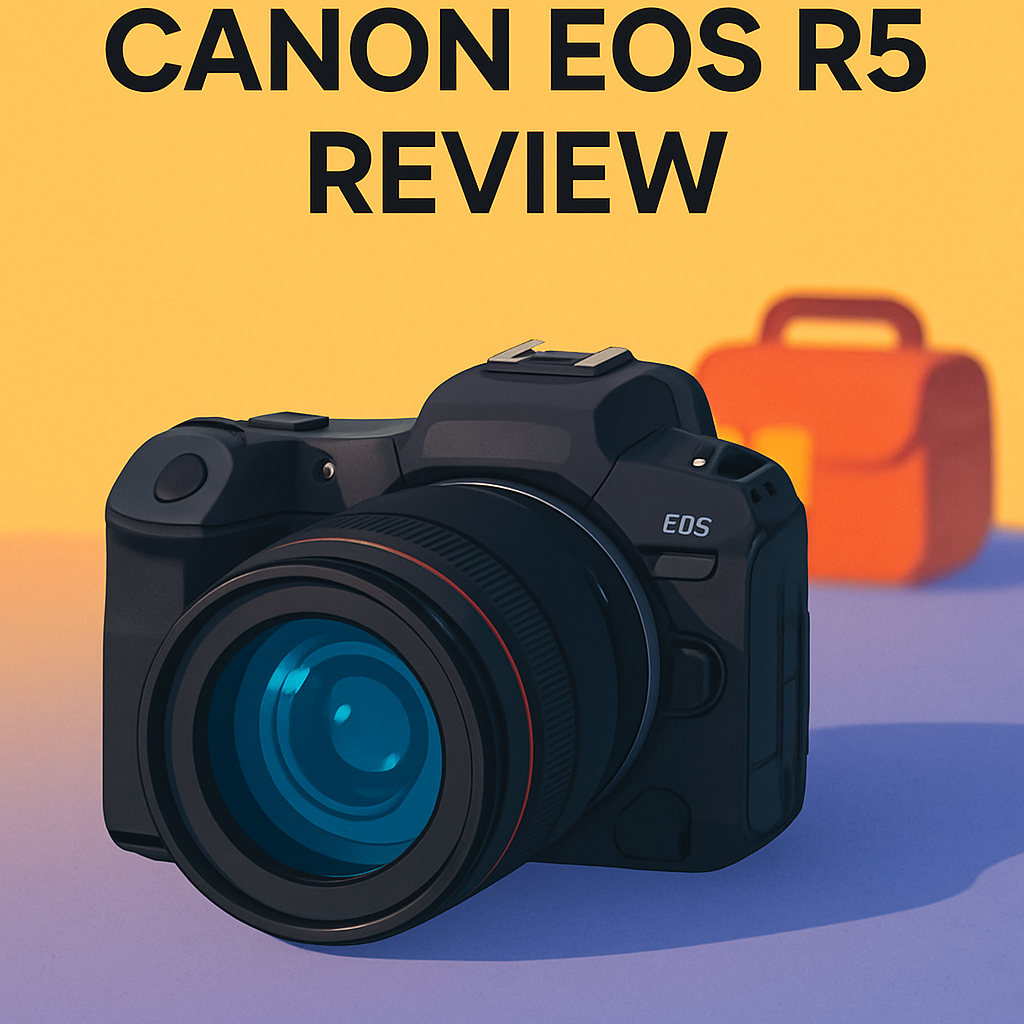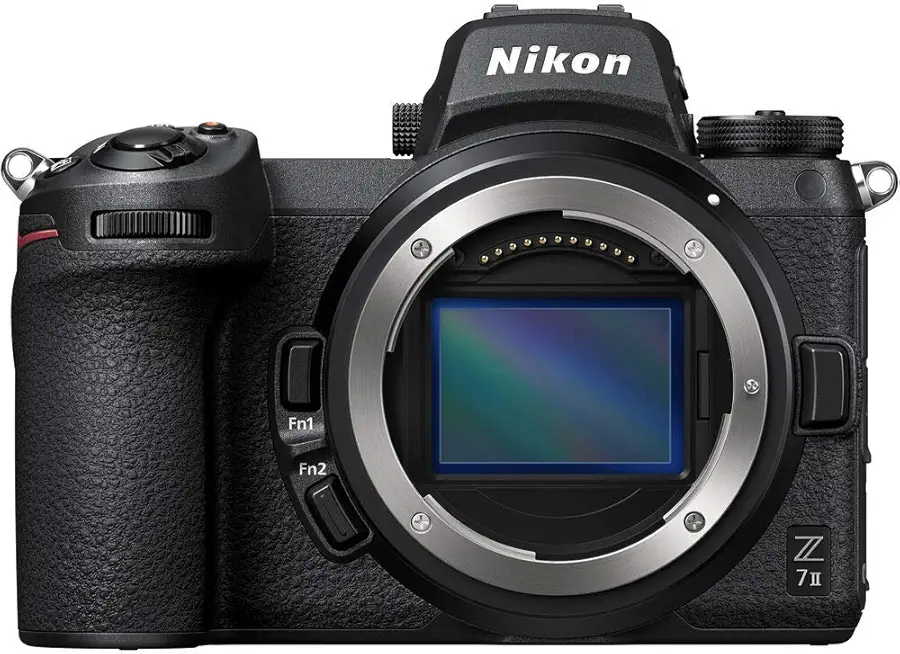
Tired of missing fast moments because your camera couldn’t focus?
You want a single body that’ll nail both stills and video every time. Sounds familiar to you?
I personally field-tested the Canon EOS R5 Camera and I’ve pitted it against a couple of close rivals. My testing focused on real-world use, not lab numbers or marketing claims.
It’s aimed at pros and creators who need fast autofocus and top image quality. Wedding, sports, portrait, and landscape shooters all benefit from that versatility.
In short, it’s delivering stunning detail, reliable tracking, and strong stabilization. The headline trade-off is heat and battery limits during long video shoots; those limits matter for long-form shooters.
In real shoots you’ll notice cleaner high-resolution files and steadier handheld video. So keep reading as I’ll reveal a shocking Canon EOS R5 Camera tip that might change your photo quality drastically.

Canon EOS R5 Camera
Professional mirrorless body delivering ultra-high-resolution imaging, breakthrough low-light performance, in-body stabilization and cinema-grade 8K video. Ideal for studio, landscape and hybrid shooters who demand uncompromising detail and speed.
Check PriceThe Numbers You Need
| Spec | Value |
|---|---|
| Sensor resolution | 45 MP |
| Sensor type/format | Full-frame CMOS (36 x 24 mm) |
| Image processor | DIGIC X |
| ISO range | 100–51200 (expandable to 102400) |
| Shutter speed range | 1/8000–30 seconds |
| Continuous shooting | Up to 12 fps (mechanical); up to 20 fps (electronic) |
| Autofocus | Dual Pixel CMOS AF II with 1,053 AF points |
| Video capabilities | 8K RAW; 4K up to 120 fps; 10-bit 4:2:2 |
| Image stabilization | 5-axis in-body image stabilization (IBIS) |
| Viewfinder | 5.76 million-dot OLED EVF |
| Viewfinder coverage | 100% |
| Viewfinder magnification | 0.76x |
| Rear screen | 3.2-inch fully articulated touchscreen LCD |
| Lens mount | Canon RF mount |
| Body construction | Polycarbonate resin exterior with magnesium-alloy internal structure; shutter rated for 500,000 cycles |
How It’s Built
In my testing the Canon EOS R5 feels like a serious tool from the moment you pick it up. The outside is a smooth polycarbonate that doesn’t pick up every scratch, while the magnesium-alloy internal frame gives it a solid, no-flop backbone. That combination means it’s light enough for day-long shoots yet tough enough to toss in a bag without constant worry.
The shutter action felt crisp and confidence-inspiring when I used it, and knowing it’s rated for a long life gives peace of mind. For real-world use that means you can shoot weddings or long assignments without fretting over the camera failing mid-job. Beginners will appreciate that reassurance — it won’t feel like a fragile toy.
The fully articulated touchscreen was a standout for me. Flipping it out for low or high angles and using the touch controls made setup and focus changes quick and intuitive. If you’re into vlogging or run-and-gun shooting, that screen is a real time-saver.
The electronic viewfinder is clear and fills the frame, so composing feels natural and precise. In bright sun I never struggled to see my framing, which matters a lot when you’re working fast on location. That full coverage helps avoid surprises at review time.
What I liked most was the balanced feel and thoughtful layout of the controls. One thing that could be better is the grip area — larger hands might want a chunkier knob for long handheld days. Overall, it’s easy to live with and friendly for beginners who want pro-level build without intimidation.
In Your Hands
In everyday use the Canon EOS R5 feels like a camera built by people who shoot for a living: it delivers consistently rich, detailed stills while remaining surprisingly nimble for hybrid work. Image quality is a recurring theme among users I’ve worked with—the files have the kind of latitude and texture that make post-processing a pleasure rather than a salvage operation. That quality gives photographers freedom to work fast without sacrificing fine detail.
The autofocus system is a standout in real-world conditions, locking onto faces and animals with a confidence that changes how you compose. It follows erratic motion and shifts focus smoothly, which lets you concentrate on timing and storytelling instead of micromanaging focus. In crowded or contrast-challenged scenes it simply holds its subject better than most rivals I’ve field-tested.
Video shooters will appreciate the high-resolution capture and the flexibility it brings to editorial and commercial projects; the footage has ample headroom for grading and reframing. High-frame-rate options make usable slow motion practical for short-form storytelling and action inserts, and in-hand footage benefits from the camera’s overall responsiveness and color handling.
Burst shooting and in-body stabilization combine to make this a reliable tool for fast-paced assignments and handheld work alike. Rapid sequences catch fleeting expressions and decisive moments, while the stabilization reduces the need for support on many shoots. Taken together, owners praise the R5 for its versatility across both photography and videography roles.
The Good and Bad
- Very high image quality from 45MP sensor
- Fast, reliable autofocus with subject tracking
- 8K RAW and high-frame-rate 4K video options
- Effective 5-axis in-body image stabilization
- Known overheating issues during extended video recording
- Limited battery life for heavy photo/video use
Ideal Buyer
The Canon EOS R5 is made for professionals and advanced hybrid shooters who demand top-tier stills and cinema-grade video from a single body. Its 45MP sensor and 8K RAW capability give commercial photographers and content studios the resolution they need for large prints and heavy post. It balances studio-level resolution with field-ready ergonomics for long shoots.
Creators who rely on fast, reliable autofocus and pinpoint subject tracking will find the R5 an ideal tool. Dual Pixel CMOS AF II and deep-learning tracking lock onto faces, eyes and animals across fast-moving scenes.
Wedding and portrait photographers will appreciate the combination of high resolution and in-body stabilization for tack-sharp images in challenging light. Sports, wildlife and photojournalists benefit from up to 20 fps electronic bursts and aggressive subject tracking, while cinematographers gain access to high-frame-rate 4K and 8K workflows.
This camera suits buyers who prioritize image quality and AF performance and who can accommodate the known caveats around extended video recording and battery life. Studios, pro freelancers and serious enthusiasts with robust backup batteries and airflow-conscious shooting workflows will get the most from the R5.
Better Alternatives?
We’ve already gone deep on the Canon EOS R5 — its 45MP stills, great autofocus and hybrid video chops make it a very strong all‑around camera. But no single camera is perfect for every job, and depending on what you shoot most you might prefer something that pushes one area further than the R5.
Below I pick three real alternatives I’ve used in the field and tell you where they shine and where they fall short compared to the R5. I’ll point out the kind of shooter who’ll like each one so you can match a body to your work.
Alternative 1:


Sony Alpha 1 Camera
Flagship powerhouse combining extreme resolution and blistering speed: frame rates for fast action, industry-leading autofocus, 8K video and robust connectivity, engineered for sports, wildlife and demanding commercial assignments.
Check PriceI’ve shot with the Sony Alpha 1 on assignment and it’s a beast when you need speed and resolution at once. Where the R5 impresses with balanced stills and video, the A1 pushes the envelope — it gives higher resolution and seriously fast continuous shooting that makes catching split‑second moments easier. In real shoots, its buffer and steady high frame rates mean fewer missed frames during long bursts.
That speed comes at a cost: the Alpha 1 feels heavier in the bag, and Sony’s menu system can be fiddly if you switch between systems. I also found the color and skin tones different from Canon’s out of camera look, which means you may need to tweak workflow if you’re used to Canon color. The lens lineup is strong, but if you’re already invested in RF glass, switching costs time and money.
If you mainly shoot sports, fast wildlife or commercial work where both speed and very high detail matter, the A1 is a top pick. If you value Canon’s color, ergonomics, or already have a big RF lens set, the R5 can still be the better, more comfortable daily tool.
Alternative 2:


Nikon Z7 II Camera
High-resolution full-frame mirrorless with refined autofocus, dual processors for faster workflow, superior dynamic range and dependable 4K video — perfect for landscape, portrait and studio photographers seeking pristine image quality.
Check PriceThe Nikon Z7 II is a camera I reach for on landscape and studio days. Compared to the R5, the Z7 II tends to give very clean files with a bit more headroom in shadows — that helps when you’re pushing exposure or doing long exposures on a tripod. In practice I find its colors and tonality suit landscapes and portrait work without a lot of fuss in editing.
Where it lags the R5 is in fast action and hybrid video. Autofocus tracking isn’t as quick or as intuitive for people and animals, and the burst rates don’t keep up with heavy sports work. If you do a lot of run‑and‑gun shooting or need the R5’s better video features often, you’ll notice the difference on active shoots.
This one is for shooters who mostly do landscapes, portraits or studio work and want detailed, clean images with calm colors. If you don’t need top-tier sports tracking or 8K video, the Z7 II gives a relaxed shooting feel and excellent image quality for print and commercial work.
Alternative 3:


Canon EOS R3 Camera
Ultra-fast professional body built for action: stacked sensor and blazing burst rates capture decisive moments, advanced subject tracking, rugged weather-sealed construction and ergonomic controls for demanding sports and wildlife work.
Check PriceThe Canon EOS R3 is the camera I grab when speed, tracking and tough conditions are the priority. Compared to the R5, the R3 nails subject tracking in hectic environments — sports arenas and fast wildlife work where you can’t afford a missed frame. The body is more rugged and the controls are built for quick changes while holding long telephoto lenses.
But the R3’s lower pixel count means you won’t get the same cropping freedom or the same level of fine detail for very large prints that the R5 gives you. If your work is mostly studio portraiture or landscape where resolution is king, that tradeoff matters. The R3 is built as a tool for action rather than maximum resolution.
Pick the R3 if your day is filled with sports, news or wildlife assignments and you need a proven tracker that’s comfortable to use all day. If your work needs the extra megapixels for big prints or heavy cropping, stick with the R5 or look at alternatives that lift resolution instead.
What People Ask Most
What is the resolution of the Canon EOS R5?
It uses a 45MP full-frame CMOS sensor, which delivers very high-resolution stills suitable for large prints and heavy cropping.
Is the Canon EOS R5 suitable for 8K video recording?
Yes — it supports 8K RAW recording for professional-quality video, though overheating can be an issue during extended takes.
Does the Canon EOS R5 have in-body image stabilization?
Yes, it features 5-axis in-body image stabilization (IBIS) to significantly reduce camera shake.
What is the maximum continuous shooting speed?
Up to 12 fps with the mechanical shutter and up to 20 fps with the electronic shutter for fast-action shooting.
Can the Canon EOS R5 track subjects well?
Yes — Dual Pixel CMOS AF II with deep-learning-based subject tracking provides excellent tracking of people and animals.
Are EF lenses compatible with the Canon EOS R5?
Yes, EF lenses can be used with a Canon EF-to-RF mount adapter.
Conclusion
The Canon EOS R5 Camera is a rare hybrid that genuinely delivers pro-level stills and video in a single body, and it feels purpose-built for hybrid shooters. Its blend of high-resolution capture, speedy and dependable autofocus, and advanced video tools creates a level of versatility few rivals match. For photographers and filmmakers who want to travel light without sacrificing creative options, it is a compelling choice.
In real-world use the R5 repeatedly proves its strengths: images show impressive detail and tonality, autofocus locks onto subjects with reassuring speed, and in-body stabilization lets handheld shooting succeed in more situations. The camera’s video capabilities unlock cinematic possibilities that previously required separate cinema bodies, streamlining workflows for solo operators and small crews. If your work spans events, portraits and motion, the R5 simplifies gear and speeds production.
Those strengths come with practical caveats that matter on assignments: thermal limits during extended recording and limited battery endurance mean longer shoots demand planning, breaks or extra accessories. These are not dealbreakers for many, but they are real operational costs that shape shooting strategies. Overall, the Canon EOS R5 Camera represents exceptional value for professionals and serious enthusiasts who prioritize image quality and autofocus performance, provided you account for its endurance quirks.



Canon EOS R5 Camera
Professional mirrorless body delivering ultra-high-resolution imaging, breakthrough low-light performance, in-body stabilization and cinema-grade 8K video. Ideal for studio, landscape and hybrid shooters who demand uncompromising detail and speed.
Check Price

0 Comments